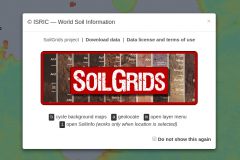SoilGrids — global gridded soil information
A system for digital soil mapping based on global compilation of soil profile data and environmental layers
We are collecting information on SoilGrids’ user base to improve the products and better understand their uses. Please help us by filling this survey: https://forms.office.com/r/Hmi1GCG7pn
SoilGridsTM (hereafter SoilGrids) is a system for global digital soil mapping that uses state-of-the-art machine learning methods to map the spatial distribution of soil properties across the globe. SoilGrids prediction models are fitted using over 230 000 soil profile observations from the WoSIS database and a series of environmental covariates. Covariates were selected from a pool of over 400 environmental layers from Earth observation derived products and other environmental information including climate, land cover and terrain morphology. The outputs of SoilGrids are global soil property maps at six standard depth intervals (according to the GlobalSoilMap IUSS working group and its specifications) at a spatial resolution of 250 meters. Prediction uncertainty is quantified by the lower and upper limits of a 90% prediction interval. The additional uncertainty layer displayed at soilgrids.org is the ratio between the inter-quantile range and the median. The SoilGrids maps are publicly available under the CC-BY 4.0 License.
Maps of the following soil properties are available: pH, soil organic carbon content, bulk density, coarse fragments content, sand content, silt content, clay content, cation exchange capacity (CEC), total nitrogen as well as soil organic carbon density and soil organic carbon stock.
For additional information please visit the SoilGrids FAQ page.
Main improvements
SoilGrids has evolved considerably since the previous release (2017), both in the methodologies employed as in the computation infrastructure and the data inputs. The following improvements can be highlighted:
- Wider selection of soil observations: more profile observations, increased quality assessment and improved and consistent standardisation across the different point datasets.
- Quantification of prediction uncertainty at pixel level with the 90% prediction interval using Quantile Random Forest.
- Improved model calibration and cross-validation procedure to better take into account the uneven spatial distribution of data points across the world.
- Improved covariates selection and model parameter tuning.
- Texture fractions modelled and mapped not independently from each other, but as compositional data with the sum of the fractions constrained to 100%.
Data Access
The latest release of SoilGrids (May 2020) can be accessed through the following services:
- WMS: access for visualisation and data overview. Instructions for using WMS with commonly used GIS software can be found here
- WCS: best way to obtain a subset of a map and use SoilGrids as input to other modelling pipelines. Examples on how to access WCS with python and R are provided here.
- WebDAV: download the complete global map(s) in VRT format. Examples can be found here.
- SoilGrids predictions are been made available on Google Earth Engine as community contributed datasets. Please see here for more details.
The data can be browsed at the new website: soilgrids.org
Acknowledgements
SoilGrids was funded from ISRIC's core funding, with additional support from the EU-H2020 CIRCASA project.
A wide range of agencies and experts have provided data for the WoSIS/SoilGrids effort; we gratefully thank them for their contributions.
Further reading:
-
SoilGrids.org — soil webmapping site
